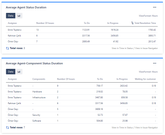Community resources
Community resources
- Community
- Products
- Jira Software
- Questions
- Need a report that shows days taken from In Development to Resolved which also will show Story Poi
Need a report that shows days taken from In Development to Resolved which also will show Story Poi
Hi
Looking for help on a query that will return all resolved JIRAs within a given time frame, and include the number of days taken since Development started until the JIRA is Resolved. I need the query to return the Story Points for each JIRA also.
Thanks
Dwight
4 answers

Hello @Dwight Pfundstein
You can try a third-party add-on - Time in Status for Jira Cloud developed by my SaaSJet team. It generates 7 types of time reports, including a Time in Status report, that shows how long an issue has been spent in each status.
In the "Total time" column you can monitor the total time that has been spent to solveeach issue.
Also, you can export data from the grid to XLSX or CSV files, which you can analyze using such tools as Excel or Google Spreadsheets.
Is that what you are looking for?
For a readymade solution, to get this data you can try out our app.
The add-on provides the time in each status for the entire lifecycle of the issue and you can filter by issue type as well. You can also combine your statuses to define your lead/cycle/resolution time and also extract the transitions history of the issues. The main features of the app are as below
- More than 8 types of Time in Status Reports. Excel Export available for all status reports.
- Time in Status
- Time with Assignee
- Time in Status with Assignee
- Time with Assignee per Status
- Status/Assignee Count
- Multiple Transition Reports
- Avg Time in status reports
- Status grouping
- Save your reports
- CSV Export
- Multiple chart types
- Dashboard Gadget
You must be a registered user to add a comment. If you've already registered, sign in. Otherwise, register and sign in.

@Dwight Pfundstein , I have used the above highlighted plugin for this same use case..
You must be a registered user to add a comment. If you've already registered, sign in. Otherwise, register and sign in.
Hello @Dwight Pfundstein
Our team at OBSS built Time in Status app for this. It is available for Jira Server, Cloud, and Data Center.
Time in Status allows you to see how much time each issue spent on each status and each assignee.


You can combine status times into Consolidated Columns to get metrics like Cycle Time, Lead Time, Resolution Time, etc.
You can add any Jira issue field (such as Story Points) as a column to the report.
For all numeric report types, you can calculate averages and sums of those durations grouped by the issue fields you select. For example total InProgress time per customer (organization) or average resolution time per week, month, issuetype, request type, etc.
And the app has a REST API so you can get the reports from Jira UI or via REST.
The app calculates its reports using already existing Jira issue histories so when you install the app, you don't need to add anything to your issue workflows and you can get reports on your past issues as well.
Time in Status reports can be accessed through its own reporting page, dashboard gadgets, and issue view screen tabs. All these options can provide both calculated data tables and charts.

Using Time in Status you can:
- See how much time each issue spent on each status, assignee, user group and also see dates of status transitions.
- Calculate averages and sums of those durations grouped by issue fields you select. (For example, see average InProgress time per project and per issue type.)
- Export your data as XLS, XLSX, or CSV.
- Access data via REST API. (for integrations)
- Visualize data with various chart types.
- See Time in Status reports on Jira Dashboard gadgets
https://marketplace.atlassian.com/apps/1211756/
EmreT
You must be a registered user to add a comment. If you've already registered, sign in. Otherwise, register and sign in.
There is a good solution for your request - Status Time Reports app developed by our team. It can display the time spent on specific statuses.
It provides reports on how much time passed in each status. It has grouping feature so that by grouping statuses(Development → In Testing→ Resolved) you can get total time. The issues are listed in a table view along with any field you want (e.g. story point). You can also export the report as CSV and open it in excel.
Once you enter your working calendar into the app, it takes your working schedule into account too. That is, "In Progress" time of an issue opened on Friday at 5 PM and closed on Monday at 9 AM, will be a few hours rather than 3 days. It has various other reports like assignee time, status entry dates, average/sum reports by any field(e.g. average in progress time by project, average cycle time by issue creation month). And all these are available as gadgets on the dashboard too.
Here is the online demo link, you can see it in action and try without installing the app.
If you are looking for a free solution, you can try the limited version Status Time Free. Hope it helps.
You must be a registered user to add a comment. If you've already registered, sign in. Otherwise, register and sign in.

Was this helpful?
Thanks!
Community showcase
Atlassian Community Events
- FAQ
- Community Guidelines
- About
- Privacy policy
- Notice at Collection
- Terms of use
- © 2024 Atlassian










You must be a registered user to add a comment. If you've already registered, sign in. Otherwise, register and sign in.